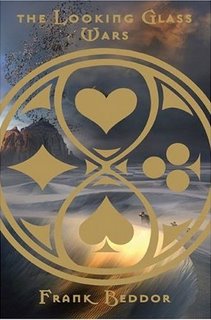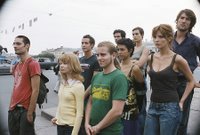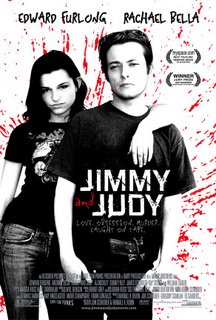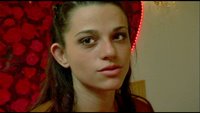Greg the Bunny: Best of the Film Parodies
 Remember Greg the Bunny from his Fox sitcom a few years back? He’s reemerged from hibernation and now appears in new short films on IFC, resulting in this new DVD compilation. This set is not to be confused with the previously released Fox series compilation; it is entirely new content.
Remember Greg the Bunny from his Fox sitcom a few years back? He’s reemerged from hibernation and now appears in new short films on IFC, resulting in this new DVD compilation. This set is not to be confused with the previously released Fox series compilation; it is entirely new content.For those of you who blinked and missed his foray into the mainstream on Fox, Greg is a lovable, dimwitted rabbit hand puppet who usually pals around with a rude ape puppet named Warren. Their Fox show presented the inventive concept that puppets were real people living and working amongst us, with Greg finding work on a children’s show where he interacted with a great cast including Seth Green, Eugene Levy, and Sarah Silverman. Of course “inventive concepts” rarely last long on network TV, so the show was promptly axed after half a season, seemingly signaling the end of the line for the fluffy bunny.
IFC resurrected the puppets this year for a series of short parodies of famous independent films. Each short lasts an average of ten minutes, so they have lots of ground to cover to hit their comedic targets. Greg is joined by Warren and fellow Fox-alum Count Blah, a blatant ripoff of the Count character from Sesame Street. A couple of other puppets are credited, but the primary three returning characters shoulder most of the workload. Greg got his start on IFC back in 1999, so it’s fitting that they have come full circle back to their first corporate home for this new series.
 Viewers expecting something similar to the Fox show are in for a surprise, because the new shorts are very raw in both production and content. The original human cast is gone with the exception of a brief appearance by Seth Green, and the concept is no longer as rooted in reality. Their return to cable allows them to say and do whatever they want, leading to frequent foul-mouthed tirades from Warren and even a near-orgy with a couple of girls (real, not puppet) during their reenactment of Auto Focus. The creators seem like giddy children on summer break, letting the puppets drop the F-bomb with aplomb throughout the series while following them around with shaky handheld cameras. Unfortunately, this creative freedom doesn’t necessarily equate to brilliance or compelling entertainment, as the finished product is very much hit or miss depending on the movie subject. For an example of their comedic taste: the easy target of Pulp Fiction features Greg struggling in a zipped-up leather gimp outfit while Warren bickers about having to play Marsellus aka “the catcher”.
Viewers expecting something similar to the Fox show are in for a surprise, because the new shorts are very raw in both production and content. The original human cast is gone with the exception of a brief appearance by Seth Green, and the concept is no longer as rooted in reality. Their return to cable allows them to say and do whatever they want, leading to frequent foul-mouthed tirades from Warren and even a near-orgy with a couple of girls (real, not puppet) during their reenactment of Auto Focus. The creators seem like giddy children on summer break, letting the puppets drop the F-bomb with aplomb throughout the series while following them around with shaky handheld cameras. Unfortunately, this creative freedom doesn’t necessarily equate to brilliance or compelling entertainment, as the finished product is very much hit or miss depending on the movie subject. For an example of their comedic taste: the easy target of Pulp Fiction features Greg struggling in a zipped-up leather gimp outfit while Warren bickers about having to play Marsellus aka “the catcher”.When it hits its mark, the show offers amusing send-ups of easily recognizable movies. Shorts in this plus column include parodies of 2001, Annie Hall, and The Godfather. The Annie Hall parody finds Greg in love with a real lobster as he obsesses over their relationship in inimitable Woody Allen fashion. In their version of 2001, Greg and Warren comically battle the evil red eye of Hal the computer, although they missed an opportunity to have Warren interact with the famous black monolith on Earth. Their Godfather parody follows the source material the closest, cramming the key plot points into a highly condensed, tightly scripted episode.
 Their failures are usually the result of playing too loose with the original films, sometimes becoming so sidetracked on needless stream of consciousness rambling and improvisation that it’s hard to figure out which film is being lampooned. They expend quite a bit of time on material that would usually end up on the cutting room floor or solely in deleted scenes, such as the characters discussing their thoughts about any given scene rather than just performing the scene. This gives the impression that they’re just winging it at times rather than focusing on creating insightful content. Sophomoric, meandering humor has its place, but in this extremely compact format they really don’t have the luxury to mess around. The second half of the season holds together much better than the first, so it’s hopeful that they have worked out the kinks as they move on to a new season.
Their failures are usually the result of playing too loose with the original films, sometimes becoming so sidetracked on needless stream of consciousness rambling and improvisation that it’s hard to figure out which film is being lampooned. They expend quite a bit of time on material that would usually end up on the cutting room floor or solely in deleted scenes, such as the characters discussing their thoughts about any given scene rather than just performing the scene. This gives the impression that they’re just winging it at times rather than focusing on creating insightful content. Sophomoric, meandering humor has its place, but in this extremely compact format they really don’t have the luxury to mess around. The second half of the season holds together much better than the first, so it’s hopeful that they have worked out the kinks as they move on to a new season.The DVD set has a generous supply of extras including commentary on all episodes, deleted scenes, gag reel footage, and two featurettes. Additionally, each episode has its own DVD title screen and custom introduction. None of the extras are essential material, but fans of the puppets are sure to appreciate the bountiful bonus content supplementing these occasionally amusing shorts. Check out a trailer of the series here.





















